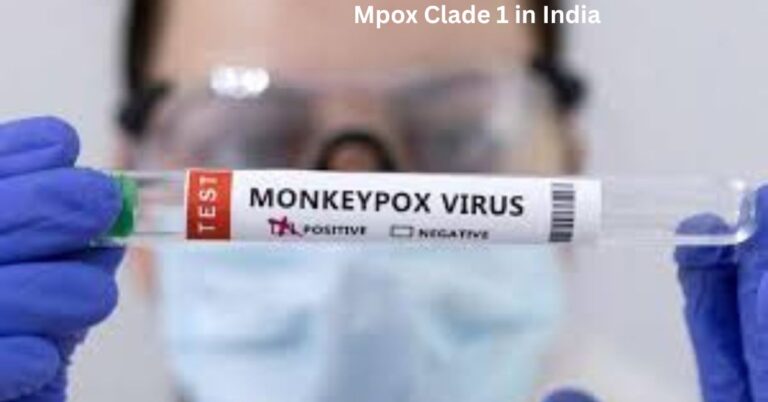Introduction
Mpox Clade 1, a viral illness as quickly as taken into consideration unusual, is now sparking developing concerns in India’s fitness panorama. As instances emerge globally, India is not any exception to this fashion. A virus intently associated with smallpox, Mpox (previously known as monkeypox), has advanced, especially with the upward thrust of Clade 1, raising new challenges for public fitness authorities. In this newsletter, we will discover what Mpox Clade 1 is, how it’s miles affecting India, and what preventive measures are in place to manipulate its unfold. Understanding this evolving state of affairs is crucial to ensuring public awareness and safety.
What is Mpox Clade 1
Mpox is a zoonotic virus, which means that it can switch from animals to people. The disease is resulting from the monkeypox virus, which belongs to the Orthopoxvirus genus, the equal family due to the fact that it is the smallpox virus. Mpox is categorised into two critical clades: Clade 1 and Clade 2. Clade 1 is known for its higher virulence and mortality prices, making it a wonderful issue in areas like India, where population density and mobility complicate manipulation efforts.
A Quick Look into History
Before diving deeper into Clade 1, it’s important to recognize Mpox’s origins. First located in 1958 in monkeys, the virus has since unfolded to human beings, with the primary recorded human case in 1970. Originally seen in African international locations, Mpox outbreaks were particularly contained till state-of-the-art years even as the virus started out to unfold to specific continents, including Asia and Europe. This marks an awesome turning point within the virus’s epidemiology, with Clade 1 proving to be extra unstable than previous lines.
Symptoms of Mpox Clade 1
Mpox provides signs just like those of smallpox but is commonly milder. These encompass fever, rash, and swollen lymph nodes. In instances of Clade 1, the rash has a tendency to be more substantial, and complications can encompass pneumonia, secondary bacterial infections, or even encephalitis. The incubation length tiers between 5 and 21 days, with signs and symptoms typically acting in the first week. The greater excessive manifestations in Clade 1 warrant close scientific attention to avoid speedy deterioration.
How is Mpox Clade 1 transmitted?
Transmission of Mpox Clade 1 occurs in maximum instances through direct contact with infected humans or animals. Human-to-human transmission can display up through respiratory droplets, bodily fluids, and skin lesions, making it exceptionally contagious in crowded settings. Unlike airborne viruses like COVID-19, close contact is normally critical for transmission. However, the ease with which it spreads in urban environments poses an enormous public health task in a rural country like India, in which many stay in near quarters.
Mpox Clade 1 in India
In India, the primary instances of Mpox had been detected in 2022. Although the disorder turned into something imported via global tourists, neighborhood transmission has, for the reason that it has been documented. Indian public fitness authorities are on excessive alert, given the capability for network spread, particularly with Clade 1’s heightened severity. So some distance, most important cities like Delhi and Mumbai have recommended clusters of cases, sparking concerns about how the virus may also evolve inside the coming months.
Why India’s Population Density Matters
India is the world’s second-most populous country, with over 1.four billion humans. In densely populated areas, specifically urban slums, ailment transmission happens an awful lot faster. Crowded transportation systems and excessive social interaction increase the opportunities of an endemic. For MPOX Clade 1, this indicates faster transmission expenses and a better hazard of large-scale outbreaks, specifically if preventive measures are not strictly enforced. Public attention and conduct might be important in controlling this.
Challenges Facing India in Managing Mpox
One of the important things worrying India faces in handling Mpox Clade 1 is its healthcare infrastructure. Despite super upgrades, public healthcare structures in rural regions often struggle with resource boundaries. In those areas, the right of entry to specialized hospital therapy is restrained, making it harder to choose out and isolate instances fast. Additionally, wrong facts and stigma around infectious illnesses can save you humans from in search of properly timed clinical attention, further complicating efforts to include the virus.
Government Measures to Combat Mpox Clade 1
The Indian government, mastering from preceding outbreaks, has carried out stringent screening measures at airports and international journey hubs. Individuals showing symptoms and signs and symptoms of Mpox are isolated and tested to prevent neighborhood transmission. Public fitness campaigns are being rolled out to raise interest about the symptoms and signs of the virus. In addition, efforts to train healthcare personnel about Mpox are underway, making sure faster identity and remedy times. These steps are vital, but the hastily evolving scenario needs non-stop vigilance.
The Role of Vaccines in Preventing Spread
While no unique vaccine has been developed totally for Mpox, the smallpox vaccine has proven effectiveness in providing move protection. India has a record of successful smallpox eradication efforts, and the U.S. is thinking about the usage of current vaccine stocks to control Mpox outbreaks. However, given the differences between Mpox Clade 1 and previous viruses, studies into more targeted vaccines are underway. In the meantime, preventive measures like vaccination in immoderate-hazard populations can provide a critical protection line.
Comparing Mpox Clade 1 to COVID-19 in India
When evaluating the Mpox outbreak to the COVID-19 pandemic, a few similarities and differences upward push up. While both are viral illnesses able to spread through human touch, Mpox has a much lower transmission price than COVID-19. However, the severity of Clade 1 means that even a small kind of instance can fast grow right right into a public health disaster if now not well contained.
The Global Response to Mpox Clade 1
India isn’t always dealing with the Mpox assignment in isolation. The World Health Organization (WHO) and special worldwide bodies are carefully monitoring the situation. International cooperation is essential in knowing the virus’s evolution, especially with Clade 1 being a specifically new chance. Remedy protocols are aligned with modern-day scientific studies.
Preventive Measures You Can Take
While the authorities play a massive role in handling public fitness crises, people ought to additionally take responsibility. Basic hygiene practices, along with washing arms regularly, keeping off contact with infected people, and carrying masks in crowded areas, can significantly lessen the risk of transmission. Awareness is your first line of protection. Be privy to signs and signs in yourself and others, and are looking for medical assistance at once in case you suspect contamination.
The Importance of Early Detection
Like with any viral outbreak, early detection plays a crucial function in controlling Mpox. Identifying the disorder in its initial tiers allows healthcare experts to isolate and deal with patients earlier than the virus spreads further. India’s surveillance structures are improving, with more speedy testing and phone tracing in the area. However, the cooperation of the public is critical in reporting suspected times and adhering to quarantine guidelines while important.
How India Can Build a Long-Term Strategy
To manipulate Mpox Clade 1 and future public fitness threats, India needs recognition for constructing strong healthcare structures. This consists of making an investment in sickness surveillance, ensuring nicely timed access to healthcare services, and enhancing vaccine distribution networks. In addition, public health campaigns aimed toward educating the population about zoonotic illnesses can foster better community-degree prevention. Addressing those long-term annoying conditions will require India to deal with no longer the most effective Mpox but other rising viral threats in the future.
Conclusion
Mpox Clade 1 is emerging as a full-size public fitness hazard in India, requiring immediate and prolonged-term responses. With its higher severity and transmission dangers, this class poses challenges for densely populated areas. However, by studying from past tales with infectious diseases and improving healthcare infrastructure, India can navigate this new chance successfully. Public interest, early detection, and global collaboration will all play crucial roles in controlling the unfold of Mpox Clade 1.

